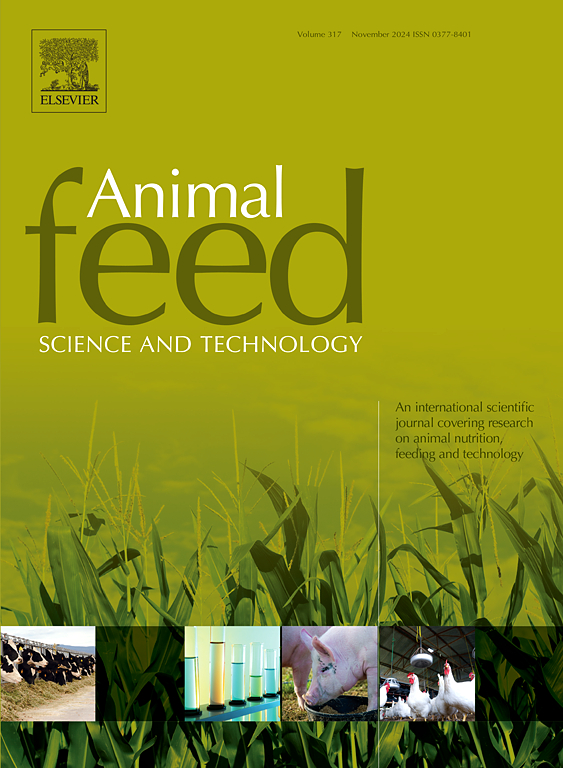走向高效的三叶草生物精炼:收获方法和延迟加工的影响
IF 2.5
2区 农林科学
Q1 AGRICULTURE, DAIRY & ANIMAL SCIENCE
引用次数: 0
摘要
本文描述了不同的收获技术和加工时间延迟对通过生物精炼从生长在丹麦的草-三叶草混合物中提取的蛋白质的产量和质量的影响。采用两种收获方法-割草和切碎-随后的处理立即或在6或12 小时后进行。粗蛋白质(CP)和氨基酸(AA)含量与豆粕(SBM)相当。收获后立即生产的蛋白质浓缩物中CP的标准化回肠消化率(SID)分别为71.0 %和69.2 % (P >; 0.05)。延迟加工降低了CP的SID (P = 0.005)和所有AA的SID (P <; 0.05)。采收方式对CP的SID (P = 0.006)和所有AA的SID (P <; 0.05)有总体影响,其中切碎生物量的SID值较低。从未延迟刈割的生物质中提取蛋白质的计算产量为56.8 kg可消化CP/公顷,12 h后为43.4 kg/公顷。相比之下,延迟12小时后,切碎生物量的计算产量仅达到29.4 kg/公顷。本研究强调了收获方法的选择和及时处理在最大限度地提高蛋白质提取效率和消化率方面的重要性。研究结果提倡在生物精炼操作中加强物流和处理实践,以提高蛋白质生产的效率和资源利用。本文章由计算机程序翻译,如有差异,请以英文原文为准。
Towards efficient grass-clover biorefining: Influence of harvesting methods and delayed processing
This paper describes the effects of different harvesting techniques and processing time delays on the yield and quality of the protein extracted through biorefining from a grass-clover mixture grown in Denmark. Two harvesting methods were employed—mowing and chopping—with subsequent processing occurring immediately or after 6 or 12 hours. The extraction process produced protein concentrates with crude protein (CP) and amino acid (AA) contents equivalent to soybean meal (SBM). The standardised ileal digestibility (SID) of CP in protein concentrate produced immediately after harvest was 71.0 % and 69.2 % from the mowed and chopped biomass, respectively (P > 0.05). Delayed processing diminished SID of CP (P = 0.005) and of all AA (P < 0.05). There was an overall effect of harvest method on SID of CP (P = 0.006) and all AA (P < 0.05), with lower values from the chopped biomass. The calculated yield of protein extracted from mowed biomass without delay was 56.8 kg digestible CP/hectare and 43.4 kg/hectare after 12 hours. In contrast, the calculated yield from chopped biomass was only reaching 29.4 kg/hectare following a 12-hour delay. This research underscores the importance of harvesting method selection and timely processing in maximising protein extraction efficiency and digestibility. The results advocate for enhanced logistics and handling practices in biorefining operations to improve efficiency and resource utilisation in protein production.
求助全文
通过发布文献求助,成功后即可免费获取论文全文。
去求助
来源期刊

Animal Feed Science and Technology
农林科学-奶制品与动物科学
CiteScore
6.00
自引率
6.20%
发文量
266
审稿时长
3 months
期刊介绍:
Animal Feed Science and Technology is a unique journal publishing scientific papers of international interest focusing on animal feeds and their feeding.
Papers describing research on feed for ruminants and non-ruminants, including poultry, horses, companion animals and aquatic animals, are welcome.
The journal covers the following areas:
Nutritive value of feeds (e.g., assessment, improvement)
Methods of conserving and processing feeds that affect their nutritional value
Agronomic and climatic factors influencing the nutritive value of feeds
Utilization of feeds and the improvement of such
Metabolic, production, reproduction and health responses, as well as potential environmental impacts, of diet inputs and feed technologies (e.g., feeds, feed additives, feed components, mycotoxins)
Mathematical models relating directly to animal-feed interactions
Analytical and experimental methods for feed evaluation
Environmental impacts of feed technologies in animal production.
 求助内容:
求助内容: 应助结果提醒方式:
应助结果提醒方式:


